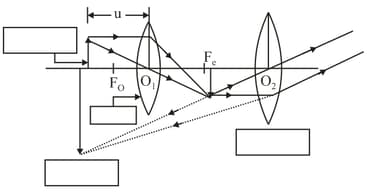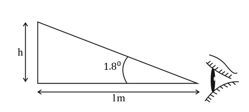Optical Instruments
Optical Instruments: Overview
This topic consists of various concepts like Optical Instruments,Eye as Optical Instrument,Defects of Eye, etc.
Important Questions on Optical Instruments
An astronomical telescope uses two lenses of powers 10 D and 1 D.Its magnifying power in normal adjustment would be:
The expression for magnifying power of compound microscope is
The expression for astronomical telescope magnifying power is
What is astigmatism? How is it corrected?
In a compound microscope, the intermediate image is
The focal lengths of the objective and the eye piece of a compound microscope are and respectively. The distance between the objective and the eye piece is The final image formed by the eye piece is at infinity. The two lenses are thin. The distance in of the object and the image produced by the objective, measured from the objective lens, are respectively
Which one of the following telescopes contains only mirrors?
You are given two compound microscopes labelled as and . The focal length of objective and eyepiece of is and respectively and that of is and respectively. Which microscope would you prefer and why?
A microscope has an objective of focal length and an eye-piece of focal length . If the distance between objective and eye-piece is is the approximate value of magnification produced for relaxed eye?
Tube length of a compound microscope is equal to . The focal length of objective and eyepiece is equal to and respectively. The magnification produced by the compound microscope when the final image is produced at infinity, is approximately
Study the diagram and answer the questions given below.

(a) Name the optical instrument shown in the diagram.
(b) Label the diagram correctly.
(c) Write the working of this instrument.
A normal human eye can see an object making an angle of at the eye. What is the approximate height of object which can be seen by an eye placed at a distance of from the object?


A normal human eye can see an object making an angle of at the eye. What is the approximate height of the object which can be seen by an eye placed at a distance of from the object?
We can see that in normal eye the things taking part in refraction are the cornea, aqueous humour, crystalline eye lens and the vitreous humour. Let us assume that we consider only things namely the cornea and the eye lens. The power of the cornea is fixed and equal to . The ciliary muscles can change the power of the eye lens which varies between to . Calculate the least distance of distinct vision for such an eye.
Which of the following is correct regarding microscope and telescope?
What is the focal length of a healthy human?
Draw a ray diagram of astronomical telescope for the final image formed at infinity.
An angular magnification of is desired using an objective of focal length and an eye piece of focal length . How will you set up the compound microscope for the final image formed at least distance of distinct vision?
Draw a ray diagram of compound microscope for the final image formed at least distance of distinct vision?
A jeweller examines a diamond through a small magnifying glass (called a loupe) having an angular magnification of . The near point of her eye is and she wants the image to be located at the near point. The focal length of the loupe should be

